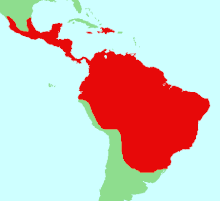Nyctibius
| Potoo | |
|---|---|
 |
|
| Northern potoo | |
| Scientific classification | |
| Kingdom: | Animalia |
| Phylum: | Chordata |
| Class: | Aves |
| Order: | Caprimulgiformes |
| Family: |
Nyctibiidae Chenu & des Murs, 1851 |
| Genus: |
Nyctibius Vieillot, 1816 |
| Species | |
|
See text. |
|
 |
|
| Global range (In red) | |
See text.
Potoos (family Nyctibiidae) are a group of near passerine birds related to the nightjars and frogmouths. They are sometimes called poor-me-ones, after their haunting calls. There are seven species in one genus, Nyctibius, in tropical Central and South America.
These are nocturnal insectivores which lack the bristles around the mouth found in the true nightjars. They hunt from a perch like a shrike or flycatcher. During the day they perch upright on tree stumps, camouflaged to look like part of the stump. The single spotted egg is laid directly on the top of a stump.
The potoos are today an exclusively New World family, but they apparently had a much more widespread distribution in the past. Fossil remains of potoos dating from the Oligocene and Eocene have been found in France and Germany. A complete skeleton of the genus Paraprefica has been found in Messel, Germany. It had skull and leg features similar to those of modern potoos, suggesting that it may be an early close relative of the modern potoos. Because the only fossils other than these ancient ones that have been found are recent ones of extant species, it is unknown if the family once had a global distribution which has contracted, or if the distribution of the family was originally restricted to the Old World and has shifted to the New World.
A 1996 study of the of the potoos supported the monophyly of the family although it did not support the previous assumption that it was closely related to the oilbirds. The study also found a great deal of genetic divergence between the species, suggesting that these species are themselves very old. The level of divergence is the highest of any genus of birds, being more typical of the divergence between genera or even families. This raises the possibility that there are several cryptic species to be discovered. For example, the northern potoo was for a long time considered to be the same species as the common potoo, but the two species have now been separated on the basis of their calls. In spite of this there is no morphological way to separate the two species.
...
Wikipedia
